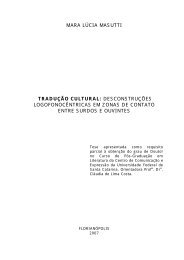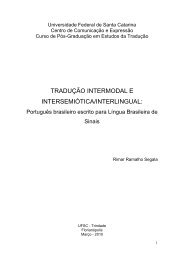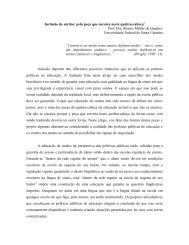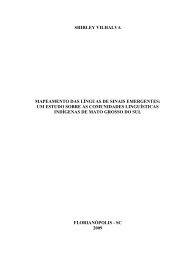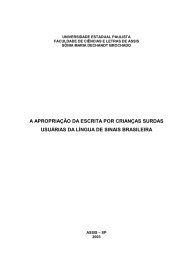Phrase Structure of Brazilian Sign Language - Ronice.cce.prof.ufsc.br
Phrase Structure of Brazilian Sign Language - Ronice.cce.prof.ufsc.br
Phrase Structure of Brazilian Sign Language - Ronice.cce.prof.ufsc.br
Create successful ePaper yourself
Turn your PDF publications into a flip-book with our unique Google optimized e-Paper software.
(46) English<<strong>br</strong> />
a) She/he likes (agreement)<<strong>br</strong> />
b) She/he liked (past tense)<<strong>br</strong> />
c) *She/he likesed (agreement, past tense)<<strong>br</strong> />
The final characteristic that I want to discuss is presented by Bobaljik<<strong>br</strong> />
for Non-Free Agr languages. He shows that in these languages, verbs surface in V,<<strong>br</strong> />
since they are adjacent to the inflection projection. Although this is hard to see in<<strong>br</strong> />
LSB, I assume the existence <strong>of</strong> a virtual affix that must be adjacent to V. The<<strong>br</strong> />
examples that follow present the structure assumed for plain verbs.<<strong>br</strong> />
(47) English (Bobaljik, 1995:272, example number (7))<<strong>br</strong> />
[IP [D(P) Sam [I’ [I [past] [VP [V eat [D(P) lunch]]]]]]]<<strong>br</strong> />
Sam ate lunch<<strong>br</strong> />
(48) LSB<<strong>br</strong> />
[IP [D(P) JOHN [I’ [I [∅] [VP [V EAT [D(P) RICE]]]]]]]<<strong>br</strong> />
John eats rice.<<strong>br</strong> />
3 <strong>Phrase</strong> <strong>Structure</strong>s <strong>of</strong> LSB<<strong>br</strong> />
Based on the evidence discussed up to this point, I assume that there<<strong>br</strong> />
are two possible representations that languages can a<strong>cce</strong>ss: the functional projection<<strong>br</strong> />
<strong>of</strong> agreement and tense, as proposed in the spirit <strong>of</strong> Pollock (1989), and the<<strong>br</strong> />
functional projection <strong>of</strong> only one inflection category IP, in the spirit <strong>of</strong> Chomsky<<strong>br</strong> />
(1995). Instead <strong>of</strong> putting these two analyses in opposition, I put them together to<<strong>br</strong> />
capture different behavior <strong>of</strong> languages. Actually, this is a natural result from the<<strong>br</strong> />
minimalist point <strong>of</strong> view, since projections result from features that have some<<strong>br</strong> />
independent motivation from the interfaces. When there is no motivation, there is no<<strong>br</strong> />
reason to have a functional projection. Also, I assume both possibilities for LSB,<<strong>br</strong> />
since there are plain verbs that activate an affixal approach, and inflecting verbs that<<strong>br</strong> />
activate a featural approach (as is the case with English (Lasnik, 1995)). The relation<<strong>br</strong> />
that I establish between these two analyses is in accord with the minimalist<<strong>br</strong> />
investigation that is based on economy principles.<<strong>br</strong> />
Figure 1 – <strong>Phrase</strong> <strong>Structure</strong> Projected with Plain Verbs<<strong>br</strong> />
IP<<strong>br</strong> />
Spec I’<<strong>br</strong> />
Position in which<<strong>br</strong> />
The subject is generated<<strong>br</strong> />
I VP<<strong>br</strong> />
15



